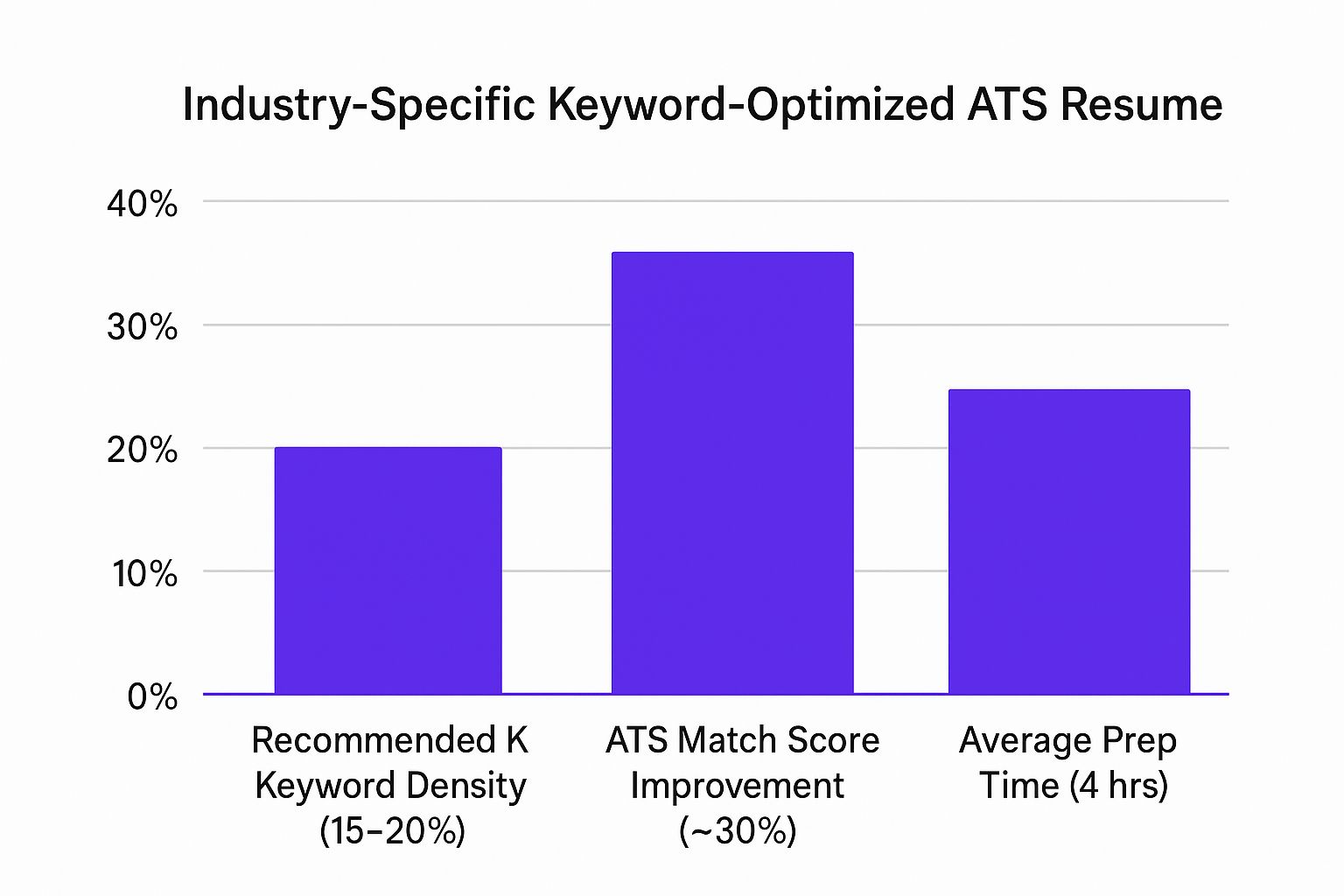6 ATS Friendly Resume Examples That Get You Hired in 2025
In today's competitive job market, your resume's first reader is almost always a machine. Applicant Tracking Systems (ATS) act as the initial gatekeepers, scanning, filtering, and ranking the vast majority of resumes submitted to companies. If your document isn't formatted for these systems, it can be automatically rejected before a human hiring manager ever sees your qualifications. Getting past this digital filter is the critical first step in any modern job search.
This guide provides more than just templates; it delivers a strategic breakdown of what makes a resume successful. We will analyze six powerful ATS-friendly resume examples, each tailored for different career scenarios. You will learn not just what to include, but why specific formatting choices, keyword placements, and structural decisions work.
Instead of generic advice, you'll get actionable tactics to build a document that consistently passes the automated screening process. By the end of this article, you will understand how to construct a resume that not only satisfies the ATS but also impresses the recruiter who reads it next, significantly increasing your chances of landing an interview. We'll explore formats from the classic chronological layout to specialized executive-level and skills-based resumes, ensuring you find the right fit for your career goals.
1. Classic Chronological ATS Resume
The Classic Chronological ATS Resume is the gold standard for a reason. It presents your career progression in a clear, reverse-chronological order, which is exactly how both human recruiters and Applicant Tracking Systems (ATS) are trained to read a resume. This format prioritizes clarity and parsability, ensuring the software can accurately extract your work history, skills, and qualifications without errors.
This approach is direct and effective, focusing on a logical flow that highlights your most recent and relevant experience first. By using standard section headers like "Work Experience," "Education," and "Skills," you make it simple for the ATS to categorize your information correctly. This tried-and-true format is one of the best ats friendly resume examples because it eliminates complexity, which is the primary cause of scanning failures.
Strategic Breakdown
The strength of this format lies in its predictability. ATS software is programmed to look for specific patterns and keywords within conventional resume sections. When you deviate with fancy graphics, tables, or unconventional section titles, you risk confusing the system.
Key Strategy: Prioritize machine-readability over complex visual design. The goal is to get your information into the system accurately so a human can eventually appreciate your qualifications.
This format excels for professionals with a consistent career path, such as a Software Engineer applying to FAANG companies or a Marketing Manager targeting Fortune 500 corporations. Its linear structure powerfully demonstrates career growth and stability.
Actionable Takeaways
To implement this format effectively, follow these specific tactical guidelines:
- Use Standard Fonts: Stick to universally recognized fonts like Arial, Calibri, or Times New Roman in a readable size (10-12pt).
- Optimize with Keywords: Carefully review the job description and strategically integrate 6-8 relevant keywords throughout your resume, especially in the "Work Experience" and "Skills" sections.
- Start with Action Verbs: Begin each bullet point with a strong action verb (e.g., "Managed," "Developed," "Accelerated") to describe your accomplishments.
- Keep Formatting Simple: Avoid using tables, columns, text boxes, headers, or footers. These elements can cause major parsing errors in many ATS platforms.
- Save in Compatible Formats: Always save and submit your resume as a .docx or .pdf file unless the application specifies otherwise. These formats preserve your layout while remaining ATS-compatible.
By adhering to these rules, you create a resume that is not only optimized for software but is also clean and easy for a hiring manager to scan quickly. If you need assistance building a resume that follows these best practices, consider using a tool designed for this purpose. You can get started with a professional ATS-friendly resume builder to ensure your document is perfectly structured.
2. Skills-Based Functional ATS Resume
The Skills-Based Functional ATS Resume flips the traditional model on its head by prioritizing what you can do over where you've done it. Instead of leading with a detailed work history, this format emphasizes your skills and core competencies, making it ideal for career changers, military veterans, or those with significant employment gaps. It allows you to group your abilities into relevant categories, immediately showcasing your qualifications for the target role.
This format is strategically designed to pass through an Applicant Tracking System while highlighting your strengths in the most favorable light. It uses clear, parsable sections like "Summary of Qualifications" and "Relevant Skills" at the top to catch the attention of both software and human reviewers. While it emphasizes skills, a well-crafted functional resume still includes a concise work history section, which is a non-negotiable element for most ats friendly resume examples to avoid being flagged as incomplete.

Strategic Breakdown
The power of this format is its ability to reframe your narrative. If a chronological history doesn't tell your best story, the functional resume lets you lead with your most compelling, job-relevant skills. This is perfect for an IT professional moving from system administration to cybersecurity or a freelance project manager seeking a full-time corporate role.
Key Strategy: Direct the reader’s focus to your capabilities and quantifiable achievements, minimizing the perceived impact of a non-linear career path or employment gaps.
By categorizing your skills (e.g., "Project Management," "Data Analysis," "Client Relations"), you make it incredibly easy for an ATS to match your qualifications against the keywords in the job description. This front-loads your value and ensures the most important information is scanned first.
Actionable Takeaways
To build a powerful skills-based resume that still beats the bots, apply these tactics:
- Create Themed Skill Categories: Group your abilities under specific, industry-relevant headings (like "Software Development" or "Digital Marketing Campaigns"). This provides structure for the ATS.
- Quantify Your Skills: Under each skill category, use bullet points to provide concrete, measurable achievements. Instead of saying "Managed social media," write "Grew social media engagement by 45% across three platforms by implementing a data-driven content strategy."
- Always Include Work History: Add a simplified "Work History" or "Professional Experience" section listing your previous employers, job titles, and dates of employment. This is crucial for satisfying ATS and recruiter expectations.
- Match Keywords to the Job: Tailor your skill categories and bullet points to mirror the language and requirements listed in the job posting. A core competencies section with 6-8 key skills is highly effective.
- Maintain Simple Formatting: Just like the chronological resume, stick to standard fonts, avoid tables or columns, and save the file as a .docx or .pdf to ensure maximum parsability.
This approach ensures you can tell your unique career story effectively without sacrificing the machine-readability needed to land an interview. For more visual guidance, the video below provides additional insights into structuring a functional resume.
3. Hybrid Combination ATS Resume
The Hybrid Combination ATS Resume offers a strategic blend of the chronological and functional formats, creating a powerful document that satisfies ATS requirements while highlighting both skills and experience. It typically begins with a robust skills summary or qualifications section, followed by a standard reverse-chronological work history. This structure provides immediate, keyword-rich context for the ATS and recruiters alike.
This format is particularly effective because it allows you to lead with your most valuable competencies before detailing where you applied them. By front-loading critical skills, you ensure the ATS captures your primary qualifications instantly. This makes it one of the most versatile ats friendly resume examples, ideal for career changers or professionals in technical fields where specific abilities are paramount.

Strategic Breakdown
The power of the hybrid format is its dual-focus approach. The initial skills section acts as a keyword-optimized introduction, perfectly tailored to the job description. The subsequent chronological section provides the necessary proof and context, showing a clear career progression that both software and hiring managers can easily follow.
Key Strategy: Combine a high-impact skills summary with a traditional work history to maximize keyword density and demonstrate a clear career narrative. This balances immediate qualification with detailed experience.
This resume works well for senior managers, technical specialists like software developers, or healthcare professionals with extensive certifications. It allows them to showcase specialized expertise upfront without sacrificing the structural integrity that an ATS expects from a chronological history. For instance, a project manager can highlight certifications like PMP and Agile methodologies before detailing the successful projects they led. A great way to begin this section is with a strong opening statement; you can use a resume summary generator to craft a compelling introduction.
Actionable Takeaways
To build an effective hybrid resume, follow these specific tactical guidelines:
- Curate a Targeted Skills Section: Create a "Core Competencies" or "Technical Skills" section at the top. Limit this to 8-12 of the most relevant skills from the job description.
- Quantify Everything: Use metrics and data in both your skills summary and your work experience bullet points (e.g., "Led a team of 5," "Increased efficiency by 15%").
- Maintain Chronological Order: After the skills section, list your work experience in reverse-chronological order with clear start and end dates.
- Avoid Redundancy: While keywords should be present in both sections, avoid repeating the exact same phrases. Use the skills section to list the ability (e.g., "Data Analysis") and the experience section to show its application (e.g., "Analyzed user data to identify key market trends…").
- Use Standard Section Headers: Stick to clear, conventional titles like "Professional Experience," "Skills," and "Education" to ensure proper ATS parsing.
4. Minimalist Single-Column ATS Resume
The Minimalist Single-Column ATS Resume is the epitome of "less is more." It strips away all non-essential formatting to offer a clean, linear document designed for maximum compatibility. This format ensures that even the most outdated or rigid Applicant Tracking Systems can parse your information with near-perfect accuracy, as there are no columns, tables, or complex design elements to cause confusion.
This approach prioritizes pure content and readability above all else. Its single-column layout guides the ATS scanner straight down the page, from your contact information to your work history and skills, without any navigational errors. For roles in government, academia, or large, traditional corporations with strict application portals, this format is one of the most reliable ats friendly resume examples because it guarantees your qualifications are read correctly.
Strategic Breakdown
The core strength of the minimalist single-column format is its universal parsability. By eliminating potential distractions like multiple columns, intricate headers, or graphical elements, you create a document that is fundamentally machine-readable. It's a strategic choice to ensure your resume passes the initial software screening without a single error, which is often the first and most critical hurdle.
Key Strategy: Focus entirely on content quality and keyword optimization. Use strategic white space to create visual breaks and guide the reader's eye, proving that a professional appearance doesn't require complex design.
This format is ideal for candidates applying for government positions, entry-level roles in conservative industries, or any job where the application portal seems particularly basic or outdated. It puts the full spotlight on the substance of your experience, making it a powerful tool when you want your accomplishments to speak for themselves.
Actionable Takeaways
To create a highly effective minimalist resume, apply these specific guidelines:
- Prioritize Information: Place your most compelling qualifications, such as your professional summary and most recent job, in the top half of the first page.
- Leverage White Space: Use consistent spacing (e.g., a single blank line) between sections like "Work Experience" and "Education" to create a clean, organized look without relying on lines or graphics.
- Use Standard Section Headers: Stick to universally understood headers like "Professional Experience," "Skills," "Education," and "Certifications" to ensure the ATS sorts your data correctly.
- Test in Plain Text: Copy and paste your entire resume into a plain text editor (like Notepad). If the text is jumbled or out of order, your formatting is too complex and needs to be simplified.
- Stick to One Font: Choose a single, standard font like Calibri or Arial for the entire document and use only bolding and slight size changes for emphasis on headers.
5. Industry-Specific Keyword-Optimized ATS Resume
The Industry-Specific Keyword-Optimized ATS Resume is a highly targeted format designed to achieve a maximum match score with Applicant Tracking Systems. It involves a deep dive into the specific language, terminology, and acronyms of a particular industry, ensuring your resume speaks the exact dialect the ATS and hiring manager are looking for. This approach goes beyond generic keywords and focuses on the nuanced vocabulary that signals true expertise.
This method is about strategic alignment, turning your resume into a precision tool. For specialized roles like a cybersecurity specialist, this means including keywords for security frameworks (NIST, ISO 27001), or for a healthcare IT professional, using terms like "HIPAA" and "EHR." By saturating your resume with relevant, high-value keywords, you create one of the most effective ats friendly resume examples for technical or niche fields.
The following chart visualizes key metrics associated with creating a keyword-optimized resume, including the ideal keyword density and the significant impact it can have on your ATS match score.

As the data shows, a dedicated effort to optimize for keywords can dramatically improve your resume's performance, though it does require a significant time investment for each application.
Strategic Breakdown
The core principle of this resume is to mirror the language of the job description and the broader industry with surgical precision. ATS algorithms are fundamentally pattern-matching tools; they scan for specific keywords and phrases to score and rank candidates. A resume rich in these specific terms is algorithmically favored and pushed to the top of the pile.
Key Strategy: Treat each job application like a targeted campaign. Analyze multiple job descriptions for the role you want to identify a master list of essential keywords, then weave them naturally into your experience and skills sections.
This format is indispensable for professionals in technical or regulated industries. For example, a digital marketer’s resume should be populated with platform-specific language (e.g., "Google Analytics 4," "HubSpot," "Meta Ads"), while an engineer’s resume must include relevant software and methodologies ("Agile," "SOLID," "AutoCAD").
Actionable Takeaways
To build a powerful, keyword-optimized resume, follow these tactical steps:
- Analyze Job Postings: Gather 5-10 job descriptions for your target role and identify recurring keywords, skills, and qualifications.
- Use Keyword Tools: Leverage tools like Jobscan or use a dedicated resume ATS checker to compare your resume against a job description and identify gaps.
- Maintain Natural Flow: Integrate keywords seamlessly into your accomplishment bullet points. Avoid "keyword stuffing," which is jarring to human readers.
- Include Acronyms and Full Terms: To cover all bases, mention both the full term and its acronym (e.g., "Electronic Health Record (EHR)").
- Customize for Each Application: Update your keyword strategy for every single job you apply for. A one-size-fits-all resume will not pass a sophisticated ATS.
6. Executive-Level ATS Resume with Leadership Focus
The Executive-Level ATS Resume is a sophisticated format tailored for senior leaders, C-suite executives, and vice presidents. It masterfully balances the need for a powerful, high-impact presentation with the technical requirements of Applicant Tracking Systems, ensuring that a career's worth of strategic achievements is not lost to a parsing error. This format prioritizes quantifiable business impact, leadership competencies, and large-scale transformation projects.
Unlike standard resumes, this layout often begins with a concise Executive Summary or a list of Core Competencies instead of a simple objective. This immediately signals high-level expertise to both the ATS and human reviewers. As one of the more nuanced ats friendly resume examples, it proves that you can command executive presence while still adhering to the fundamental rules of ATS compatibility, making it ideal for leaders targeting roles at Fortune 500 companies, major technology corporations, or large healthcare systems.
Strategic Breakdown
The core challenge for an executive resume is conveying strategic oversight rather than just tactical duties. This format achieves this by using powerful, results-oriented language focused on metrics like P&L management, market share growth, and operational efficiency improvements. It maintains a clean, parsable structure but elevates the content to reflect senior-level responsibilities.
Key Strategy: Frame your entire career narrative around leadership and business impact. Use section headers like "Executive Leadership Experience" and populate bullet points with high-level achievements, not daily tasks.
This resume is essential for demonstrating a track record of steering organizations through significant change or growth. By leading with multi-million dollar figures, percentage-based improvements, and team sizes, you provide immediate, scannable proof of your capabilities that an ATS can easily categorize and rank highly for executive-level keywords.
Actionable Takeaways
To craft a compelling executive resume that navigates ATS filters, implement these targeted tactics:
- Lead with an Executive Summary: Start with a 3-4 line summary that highlights your key leadership qualifications, years of experience, and most significant business achievements.
- Quantify Everything: Every bullet point should answer the question "so what?" by including metrics (e.g., "Drove 35% revenue growth," "Reduced operational costs by $4M").
- Use Executive Keywords: Incorporate senior-level terminology like "strategic planning," "change management," "digital transformation," and "P&L responsibility."
- Maintain a Clean Layout: While the content is complex, the design must remain simple. Stick to a standard font, avoid graphics or tables, and ensure clear section breaks. A two-page limit is acceptable and often expected for extensive leadership histories.
- Focus on Strategic Impact: Prioritize accomplishments that show how you shaped business strategy, led teams through challenges, and delivered enterprise-wide results.
An executive resume that successfully passes through an ATS is your ticket to the next stage. Once you secure the interview, it's crucial to be prepared to discuss these high-level achievements in detail. You can prepare effectively by reviewing common executive interview scenarios and how to respond to them. Learn more about how to excel in your next leadership interview to translate your on-paper success into an in-person offer.
ATS Resume Format Comparison: 6 Key Styles
| Resume Format | Implementation Complexity 🔄 | Resource Requirements 💡 | Expected Outcomes ⭐📊 | Ideal Use Cases 💡 | Key Advantages ⚡⭐ |
|---|---|---|---|---|---|
| Classic Chronological ATS Resume | Moderate – straightforward structure | Moderate – requires keyword research | High ATS compatibility (95-98%), clear career progression 📊 | Traditional industries, steady careers | Highest ATS success, familiar format |
| Skills-Based Functional ATS Resume | Moderate to High – skill categorization | Moderate – strong keyword balance needed | Good ATS compatibility (85-90%), highlights skills effectively 📊 | Career changers, skill-heavy roles | Highlights transferable skills, gaps mitigated |
| Hybrid Combination ATS Resume | High – blending two formats strategically | High – requires keyword and content balance | High ATS compatibility (90-95%), comprehensive keyword coverage ⭐ | Mid/senior level, technical & management | Balances skills & experience, flexible |
| Minimalist Single-Column ATS Resume | Low – very simple, minimal formatting | Low – minimal design and formatting | Very high ATS compatibility (98-99%), fast parsing ⚡ | Conservative industries, govt jobs | Near-perfect ATS parsing, easy to update |
| Industry-Specific Keyword-Optimized ATS Resume | High – intense keyword research and tailoring | High – requires deep industry knowledge | Extremely high ATS ranking and interview callback rates ⭐📊 | Specialized technical roles, competitive industries | Maximizes keyword matching and ATS ranks |
| Executive-Level ATS Resume with Leadership Focus | High – requires strategic content crafting | High – executive terminology & metrics | High ATS compatibility, highlights leadership impact ⭐📊 | C-level executives, senior management | Demonstrates executive scope, strategic results |
Unify Your Strategy: From ATS-Friendly Resume to Job Offer
Throughout this guide, we've dissected six powerful ATS friendly resume examples, from the classic chronological format to the highly specialized executive resume. Each template serves as a strategic blueprint, not just a document layout. They demonstrate that beating the bots is not about luck; it's about making deliberate, informed choices that align with your unique career story and the specific roles you are targeting.
The core lesson is this: an ATS-friendly resume is a machine-readable document designed for a human reader. The ultimate goal isn't just to pass a digital gatekeeper but to present your value proposition so clearly and compellingly that a hiring manager is eager to learn more. This dual focus is the secret to moving from the applicant pile to the interview list.
Key Strategic Takeaways for Your Job Search
To consolidate everything we have covered, let's distill the most critical, actionable principles. These are the non-negotiables for crafting a resume that consistently performs well with Applicant Tracking Systems.
- Structure is Non-Negotiable: Whether you choose chronological, functional, or hybrid, the underlying structure must be clean. Stick to single-column layouts, standard fonts, and clear section headings like "Professional Experience" and "Skills." The Minimalist Single-Column example we reviewed is the gold standard for pure compatibility.
- Keywords are Your Currency: Every successful example integrated job-specific keywords naturally. Your primary task is to mirror the language of the job description in your resume's content, especially within your professional summary, work experience, and skills sections. This is a matching game, and precision wins.
- Quantify Everything Possible: Numbers cut through the noise. Metrics demonstrating your achievements (e.g., "Increased sales by 15%" or "Managed a budget of $500K") provide concrete proof of your capabilities. This tactic was central to the Executive-Level resume but applies to every career stage.
By mastering these three pillars, you transform your resume from a passive historical record into a dynamic marketing tool. You are not just listing job duties; you are building a case for why you are the best candidate for the position, using language that both the ATS and the recruiter will understand and value.
From A Great Resume to A Coordinated Campaign
An optimized resume is your ticket to the game, but winning requires a broader strategy. Simply submitting a single, static resume to dozens of openings is a recipe for frustration. The most successful job seekers treat their search like a campaign, customizing their approach for each opportunity. This is where organization and intelligent tools become a game-changer.
Think of each resume version you create as a targeted asset. The Hybrid Combination resume you use for a startup might need different keywords than the Classic Chronological version you submit to a large corporation. Keeping track of which version went where, along with the original job description and application status, is critical. This level of organization prevents confusion and empowers you to follow up intelligently. By integrating the creation of ATS friendly resume examples into a structured workflow, you move from a reactive applicant to a proactive candidate who is in full control of their job search narrative.
Ready to stop juggling spreadsheets and start managing your job search with a powerful, unified system? Eztrackr is an all-in-one job application tracker that lets you save job postings, manage your applications on a visual kanban board, and even build and tailor your resume with its AI-powered skill-match analyzer. Take control of your career journey by transforming your optimized resumes into a winning strategy with Eztrackr today.
 Interview Sidekick
Interview Sidekick